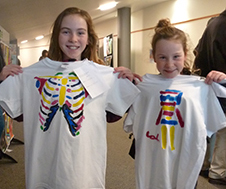 More than two hundred t-shirts were enthusiastically painted with anatomical designs by children of all ages at the Department's interactive display at the recent University Expo. Children were able to choose from stencilled designs, which included a heart, rib cage, brain slice, and a Minecraft skeleton. The Expo was held as part of the International Science Festival that ran in Dunedin from 8 – 16 July. The Department also ran tours of the W.D. Trotter Anatomy Museum, and a sculpting demonstration at the Wall St Mall that illustrated how the muscles attach to a plastic skeleton.
More than two hundred t-shirts were enthusiastically painted with anatomical designs by children of all ages at the Department's interactive display at the recent University Expo. Children were able to choose from stencilled designs, which included a heart, rib cage, brain slice, and a Minecraft skeleton. The Expo was held as part of the International Science Festival that ran in Dunedin from 8 – 16 July. The Department also ran tours of the W.D. Trotter Anatomy Museum, and a sculpting demonstration at the Wall St Mall that illustrated how the muscles attach to a plastic skeleton.
 As well as the t-shirt painting, the Department's hands-on display at the University Expo included live dissections of an animal heart and brain, and an interactive Avatar which mimics the user's hand and arm actions and shows the muscle, bone and ligaments engaged to make the movement.
As well as the t-shirt painting, the Department's hands-on display at the University Expo included live dissections of an animal heart and brain, and an interactive Avatar which mimics the user's hand and arm actions and shows the muscle, bone and ligaments engaged to make the movement.
Two hundred and seventeen people, from as far afield as the North Island and Australia, visited the W.D. Trotter Anatomy Museum throughout the two days it was open. The tours, which were booked out, began with a history of the museum and its specimens, given by museum curator Mr Chris Smith. His talk included the advancement of techniques used to create anatomical specimens, from large scale papier-mâché models through to the more modern methods of plastination and prosecting that we use today. Visitors were able to take in the vast array of specimens on show in the museum, and ask questions of the experienced anatomy staff on hand.
 Using modelling clay, a plastic skeleton and willing assistants, Dr Louisa Baillie gave a live demonstration at the Wall St Mall, creating and sculpting muscles onto a skeleton to illustrate how they function together to allow movement, strength and flexibility. Special thanks to PhD students Matthew Lee Jenkins (PE School) and Marion Kennedy, and Assistant Research Fellow Zin Khant Aung who provided actual demonstrations of the muscle movements as Dr Baillie progressively built up the skeleton to become a fully muscled person. Thanks also to the Otago Polytechnic School of Art's Sculpture Department who provided space for Dr Baillie to develop and refine the demonstration, and to their technicians who helped stabilise the plastic skeleton, including making a trolley with braking wheels for it to stand on.
Using modelling clay, a plastic skeleton and willing assistants, Dr Louisa Baillie gave a live demonstration at the Wall St Mall, creating and sculpting muscles onto a skeleton to illustrate how they function together to allow movement, strength and flexibility. Special thanks to PhD students Matthew Lee Jenkins (PE School) and Marion Kennedy, and Assistant Research Fellow Zin Khant Aung who provided actual demonstrations of the muscle movements as Dr Baillie progressively built up the skeleton to become a fully muscled person. Thanks also to the Otago Polytechnic School of Art's Sculpture Department who provided space for Dr Baillie to develop and refine the demonstration, and to their technicians who helped stabilise the plastic skeleton, including making a trolley with braking wheels for it to stand on.
Thank you to all the wonderful Anatomy staff and students who participated in these events, helping to bring our Anatomy to life.